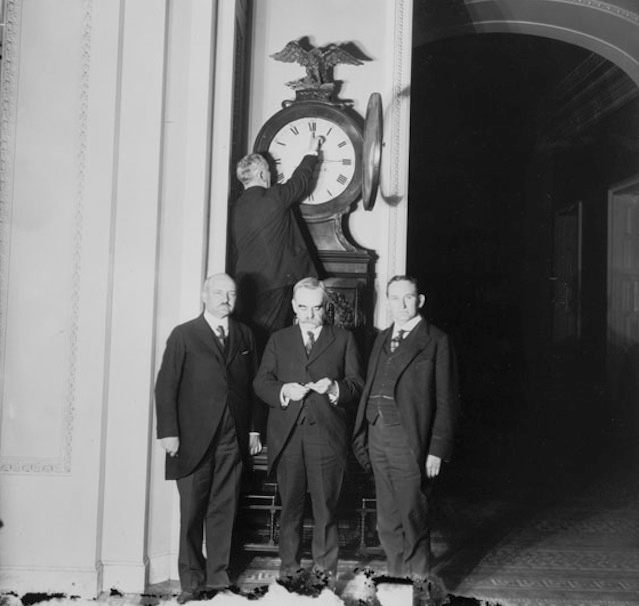Congressional Clocks Have a Secret Code

Library of Congress rotunda clock (Photo: Library of Congress)
In Washington, D.C., on Capitol Hill, there are clocks everywhere. Every Congressional office suite, according to the Architect of the Capitol, has at least three clocks in it. There are around 4,000 clocks on the House side of the Hill, and just slightly less on the Senate side. There are fancy, old clocks, that need to be regularly wound; there are newer, decorative clocks that adorn the mantlepieces of legislators’ personal offices; and there are practical wall clocks, with wide white faces, that look a lot like the clocks in elementary school hallways and classrooms.
These thousands of clocks, though, don’t just tell the time. They’re part of system more than a century old that sends signals, in a code of sounds and lights, to members of the House and Senate.
Look along the top of a Congressional wall clock, and you’ll see seven small light bulbs. Even the fancier clocks in members’ offices have them. From time to time, these will light up in particular sequences, accompanied by loud, long buzzes or series of shorter buzzes. These patterns all have meanings: they’re meant to communicate to people working on the Hill when electronic votes are called, when one chamber or the other is adjourned or in recess, and when members need to think about actually being in the Senate or House chamber.

The Senate Chamber, as it looked around 1873 (Photo: Brady-Handy Photograph Collection/Library of Congress)
Until late in the 19th century, this job belonged to pages who would walk the halls of the capitol and alert members to official goings-on. But in 1888, the House decided that it was time for machines to start taking over men’s jobs. They paid an electrical engineer $1,000 to investigate what it would take to create an electric bell system, and by 1890 (some $125,000 later) their new office building had a newfangled bell system. One reporter wrote that there was “no other word than magic” to describe it.
The doorkeeper of the House controlled the bells, and within about two decades, there was already a code of five different calls in use. In 1933, the system was updated and the mellifluous bells were replaced by more modern buzzing. In 1963, the lights were added.
More recently, “high frequency transmissions start interfering with and degrading the Capitol’s signals,” according to the Architect of the Capitol’s office, and the whole system was redone as a wireless network. There’s also now an app, created by a former Hill staffer, that will send analogous alerts right to your phone.
 Resetting the Ohio Clock (Photo: Public domain)
Resetting the Ohio Clock (Photo: Public domain)
The actual clock code is a little more complicated than your average end-of-class-or-day system of rings. Some of the signals are simple: on the House side, five bells means a five-minute electronically recorded vote. On the Senate side, one long bell means the Senate is convening.
But the code can get much more complicated, with two bells followed by two lights and then two more bells (a fifteen-minute vote by roll call) and three bells, pause, then five short bells (a 15-minute, in-person quorum call, possibly followed by a vote).
And your average bell systems don’t include a special code for a civil defense warning. That one’s pretty simple actually: 12 bells, plus six lights. That code doesn’t even need much interpretation: with all the noise and flashing lights, something bad is clearly going on.

This story appeared as part of Atlas Obscura’s Time Week, a week devoted to the perplexing particulars of keeping time throughout history. See more Time Week stories here.








Follow us on Twitter to get the latest on the world's hidden wonders.
Like us on Facebook to get the latest on the world's hidden wonders.
Follow us on Twitter Like us on Facebook